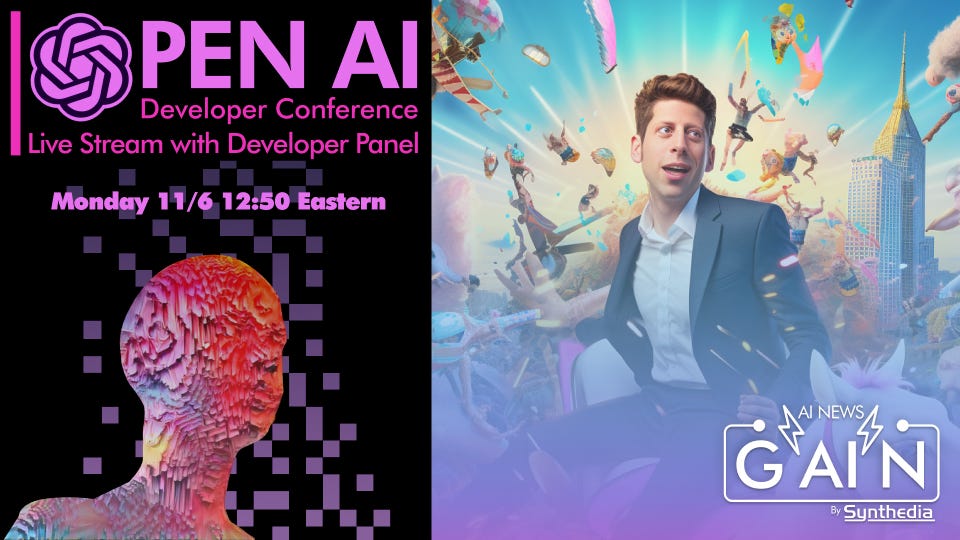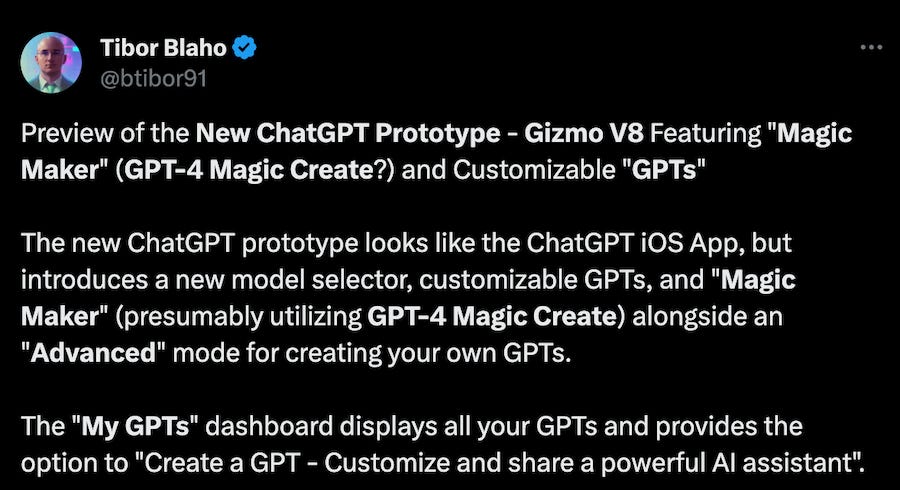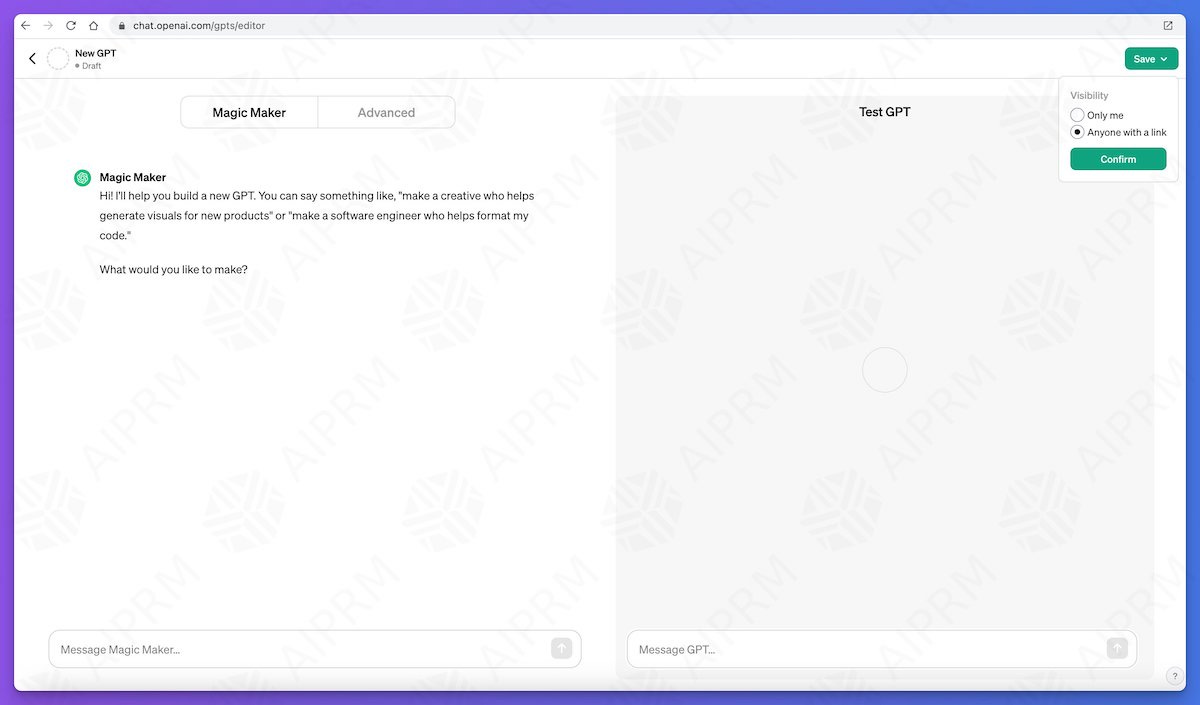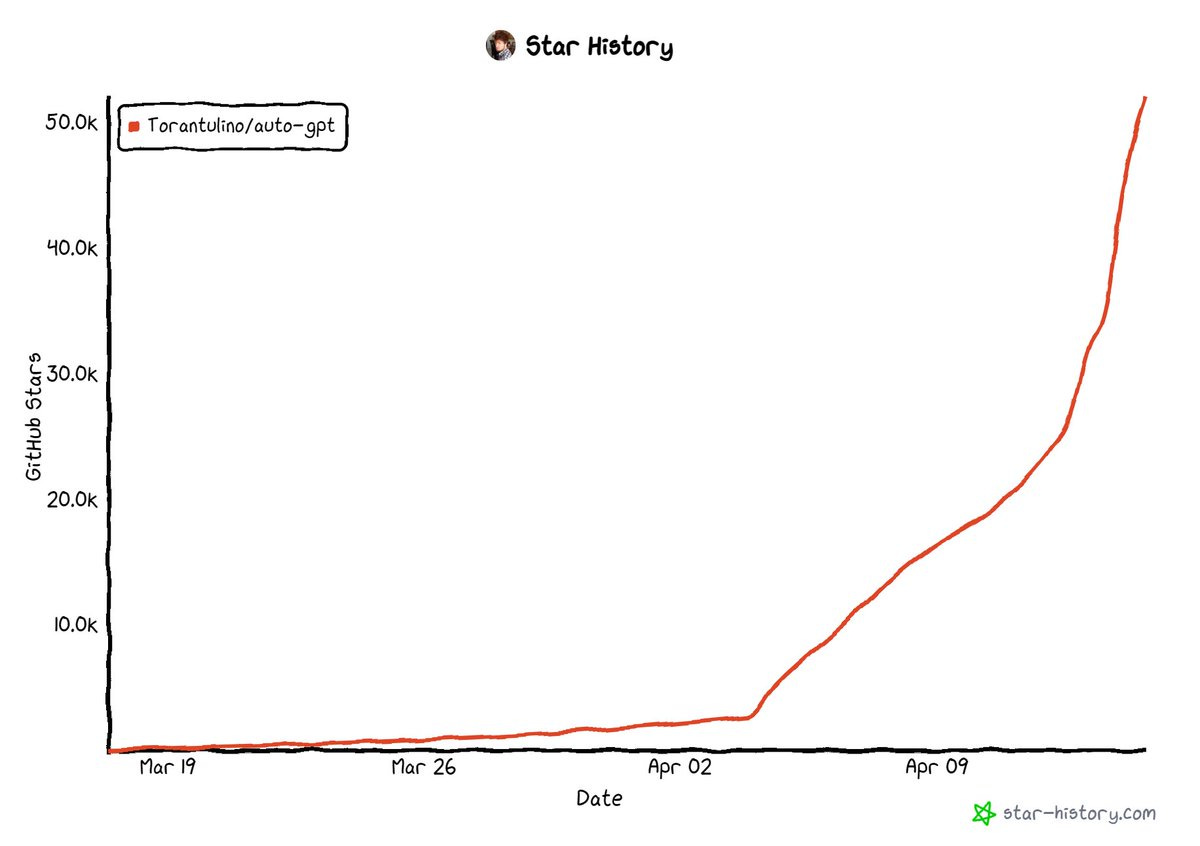OpenAI Leaks Ahead of Dev Day - Plus, a Synthedia Developer Panel and Watch Party
Agents! Your Own ChatGPT bot. And more.
OpenAI’s hotly anticipated DevDay is tomorrow. We have a preview to share with you here and also an announcement about a special episode of the Generative AI News (GAIN) livestream.
You can watch the OpenAI keynote live with Synthedia and participate in real-time commentary from our developer panel. Attend the live stream on LinkedIn or YouTube. You will see the entire keynote, and we will offer context with a discussion immediately following the event. Plus, the comments during the keynote should be great. **Note, the links changed after the original post of this article. The Buttons below are correct.
What to Expect from Dev Day
Rumors have proliferated for weeks, predicting what OpenAI will introduce during Dev Day. Below, I highlight three solutions that have a high likelihood of announcement tomorrow: My GPT, ChatGPT Team Plan, and autonomous agents.
My GPT Gizmo
You may recall that OpenAI indicated in February that it intended to allow users to “define their AI values.”
We believe that AI should be a useful tool for individual people, and thus customizable by each user up to limits defined by society. Therefore, we are developing an upgrade to ChatGPT to allow users to easily customize its behavior.
I concluded at the time that OpenAI would enable everyday users to fine-tune either their own models or experience. It appears this feature will be announced tomorrow.
Tibor Blahor’s post on X, the social media site formerly known as Twitter, said a new ChatGPT prototype has a new “‘Advanced’ mode for creating your own GPTs.”
The My GPT screen includes a text box for providing instructions about the bot, a Test GPT panel to facilitate conversations with the customized bot and a sharing button. The sharing enables you to restrict the bot to private use or share it with others via a URL link.
My GPT also enables you to add details for the bot, such as name, description, introduction (for the users), a welcome message, and prompt starters. It also lets you upload a knowledge base, which may be the most intriguing feature on the sample screen.
In addition, the creator can select from a list of actions supported by the bot. The standard actions include “Web Browsing,” “DALL-E Image Generation,” and “Code Interpreter.” That last item suggests this screen mock-up may be old. OpenAI renamed “code interpreter” to “advanced analytics” months ago. Of course, it could also suggest the information is incorrect, though it seems consistent with earlier OpenAI messaging.
One of the drawbacks of earlier digital assistants like Siri and Alexa was their limited personalization options. The capabilities highlighted by Blaho and the screenshots are not revolutionary. There are other bot-building solutions with similar features. The key difference is this enables a personalized version of ChatGPT, a significant step up from DIY bot builders.
Another X post by a user named CHOI identified additional features for My GPT, including:
Drafts - Save and share drafts of chatbots you're creating
Publishing - publicly distribute your completed chatbot
Sharing - Set up and manage chatbot sharing
Marketplace - Search and deploy chatbots created by other users
ChatGPT Team Plan
Another expected announcement is the ChatGPT Team Plan. This sounds like the self-service version of ChatGPT Enterprise for small businesses that OpenAI promised over the summer. Blaho and others have also posted about this.
CHOI added that users will be able to separate their personal and professional workspaces. In addition, CHOI mentioned a high likelihood of a GPT-4 API price reduction and faster processing time.
Autonomous Agents
There have been rumors for several weeks about autonomous agents, but OpenAI seems to have kept the details about this product out of the public discussion. However, Synthedia has two conversations this week with long-time OpenAI developers, both of whom suggested agents will be on Monday’s agenda. Bakz T. Future told me:
My guess would be they’ll launch some kind of agent API, something like AutoGPT, in addition to price cuts across the offerings except ChatGPT Plus.
You may note that there are a half dozen AutoGPT websites, of which at least two claim to be “The Official.” The original Auto-GPT tapped into GPT-4 to autonomously create a program that could execute a series of steps to fulfill a specified user (or developer) intent. Auto-GPT would extract the objective from a prompt, identify the services required to fulfill the user intent, automatically write programs to access those services, and coordinate the fulfillment of the activity.
The solution quickly rocketed to 50,000 stars on GitHub. Today, the solution has over 150,000 stars and nearly 5,000 commits from various developers adding to the project. Understandably, OpenAI wants to have its own autonomous solution for developers. AutoGPT is an open-source AI agent solution. OpenAI will surely want a proprietary version. The company views open-source solutions as its primary competitors.
Large language models (LLM) enable four different types of capabilities:
Features - LLM-powered add-ons to existing applications
Assistants - ChatGPT and similar solutions that fulfill requests
Copilots - Specialized assistants that collaborate with users to meet objectives
Agents - Programs that perform functions autonomously on behalf of users
OpenAI has APIs that enable third-party developers to implement the first three of these capabilities. Agents is a more complicated solution set, but nevertheless, it is a gap in OpenAI’s portfolio coverage. This is also a technology that combines the abilities to determine user intent, identify a solution, and write software programs to complete the desired tasks.
OpenAI’s Destination
OpenAI clearly wants to be a platform company. It will not be satisfied only with offering APIs and hoping its customers create amazing solutions while at the same time staving off commoditization. That is why it is rolling out so many features, including a no-code bot builder. It wants to maximize user adoption.
Character AI enables users to create their own bots. It seems logical that ChatGPT would want to have a piece of that market. AutoGPT has become popular with developers, and it is also logical that OpenAI wants to offer a competing product. However, there may be a downside to this approach. A company owner with a software engineering background sent me a note last night saying:
As consultants and gen-ai product owners we are feeling more and more out of breath ! 😵😰 Do you think there will be a place for ai developers/consultants to thrive?
I believe the platform objective demands that OpenAI provide a way for third-party developers to thrive on the product and monetization fronts. This does not mean OpenAI will reserve all use case categories for its customers to exploit. ChatGPT competes to some degree with Bing Chat, Jasper AI, and countless other applications built on top of OpenAI GPT APIs. ChatGPT enterprise competes with a variety of enterprise applications either directly or indirectly through features.
We won’t know for certain whether any or all of these solutions will debut during Dev Day. But Synthedia predicts all are in planned solutions that will roll out in 2024, if not during the 2023 event.
What do you think? What would you most like to see out of OpenAI this week? What are you skeptical about? Let me know in the comments.
Related Stories:












The custom GPT bot building feauture is going to put some startups out of business - and possibly some bigger ones if OpenAI grows it into a mature platform for businesses to build and maintain their chatbots on.